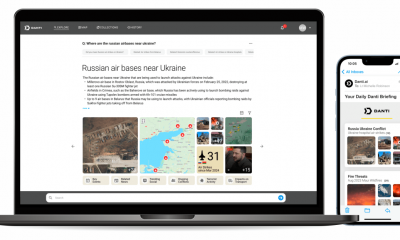Entertainment
Non-monogamy: How to get started whether single or partnered

Interest in non-monogamous relationships has soared in the past few years, evidenced by a 213 percent increase in online searches in the past year.
That may be in part because of a misconception that non-monogamy is constant orgies (or sex or hookups if orgies aren’t your thing). Not to burst your bubble, but that’s not exactly the case.
“The reality is, it’s a lot more talking than sex at the end of the day,” said Dedeker Winston, co-host of the Multiamory podcast and co-author of Multiamory: Essential Tools for Modern Relationships. “Talking supports good sex and sometimes lots of good sex but…the barrier to entry can be high, especially in particular, if you’re opening up from a monogamous relationship.”
With that in mind, if you’re interested in how to get started in non-monogamy (whether you’re partnered or single), read on for advice from Winston and other experts.
How to start a non-monogamous relationship
“The first step is a lot of self inquiry and research,” said Winston. Talk to a trusted friend or non-monogamy affirming therapist if possible — someone who won’t judge you for speaking honestly about your interest.
As for research, here are resources recommended by the experts, in addition to their own podcasts and books:
In addition to reading books and listening to podcasts, find your own non-monogamous community. If you can’t do so in real life (say through Facebook, Meetup, or dating apps), you can find likeminded people online.
Whatever resource you gravitate to, Winston advises listening to an array of voices, not just one person. There are many ways to practice non-monogamy, so it’ll benefit you to hear from multiple perspectives.
Relationship coach and co-host of the Curious Fox podcast Effy Blue utilizes the idea of relationship by design: “actively, consciously, and dynamically designing your relationship in a way that you can thrive.”
She encourages people to understand two things about themselves: what you want out of a relationship, and what it takes for you to thrive. Maybe you’re the adventurous type and the idea of exploration would help you thrive; maybe you thrive through making a home and nesting. Whatever it is, figure out these pieces of knowledge about yourself before diving into non-monogamy.
Marriage and family therapist and host of the Sluts & Scholars podcast, Nicoletta Heidegger, advises that you ask yourself questions about your upbringing, like:
-
How did I learn what kinds of relationships were acceptable?
-
What were some of the messages I received from culture and families around me about what types of relationships were okay?
This will help you figure out what you’ve been taught and what relational narratives have been pushed on you, she said.
Secondly, ask yourself questions like:
It may be hard to do this inner exploration alone, so Heidegger recommends a coach or therapist who specializes in this to help guide you, if that’s possible. Monogamy is the default of sorts, and even if we’re not explicitly taught about relationships, we learned through watching our families, media, and others around us how relationships “should” be — and that was with two people.
Once you do this internal work, if you’re already partnered, it’s time to take the leap and discuss it with them.
Want more sex and dating stories in your inbox? Sign up for Mashable’s new weekly After Dark newsletter.
How to bring up non-monogamy with your partner
Talking about non-monogamy in a currently monogamous relationship is understandably scary. Difficult emotions can come up, for one, and your partner — or you yourself — may feel like the relationship is threatened, Blue said.
Sometimes, Heidegger said, both partners take that initial interest, which makes these conversations easier. That’s not always what happens, though, so when broaching this topic, start slow. Bring it up as early as you can, Blue said; there’s no need for urgency.
The point is to open the conversation, not to open the relationship from the jump.
Don’t (DON’T!) jump in with something like, “Hey, I just read a Mashable article about non-monogamy — want to try it?”
Scale it back, by a lot. Heidegger suggested the “shit sandwich” approach: a compliment, followed by the difficult thing you need to discuss, followed by another compliment. An example she gave is:
“I love you so much. I know that I can be so safe in this relationship and that you support me and all the desires of things I share with you…I feel kind of scared sharing this with you…I’ve just read this article in Mashable about non-monogamy and…it’s something that kind of sparks an interest in me and I would really like to talk to you about it. Are you open to talking about it? I know this might feel scary. Thank you for hearing me out. I feel really loved that you’re willing to have these tough conversations with me.”
Obviously, rewrite this script the way you want to say it, but the point is to open the conversation, not to open the relationship from the jump. Winston also recommends opening the topic very gently — like referencing a Netflix show where characters had a threesome, and asking your partner if they’ve ever thought about having one.
“These conversations are likely to bring up feelings for people,” Winston said. “Make sure that there’s space for that and that there’s an energy of curiosity and inquiry and collaboration around it.”
If your partner is interested in exploring more, then repeat the first step — doing a lot of inner work and research — with them.
Some other factors in this preliminary discussion or negotiation is how you feel about sex versus other types of love and romantic relationships, Heidegger said, and how willing you are to face your feelings and insecurities.
“Obviously, insecurities and feelings come up in monogamy,” said Heidegger. “But in non-monogamy, you can’t really hide from them as much as you can in traditional monogamy.”
Think about your coping tools, support system, and how willing you are to work through triggers should they come up. This goes for monogamous couples as well, but discussing a check-in protocol is also important. (Heidegger recommends Winston’s work on a check-in protocol, which is mentioned in the Multiamory podcast and book.)
Another aspect to consider is how much you want to know about your partner’s other connections, and whether you yourself want to have a relationship with those people.
Be patient with your partner if you’re the one to bring this up, Blue said. It may have been on your mind long before you bring it up to them, but to them it’s a new idea. Blue recommends communication — but don’t overdo it. Becoming hyperfocused and constantly talking about non-monogamy isn’t healthy, so Blue warns not to let it consume you.
Know that your entry point in non-monogamy can be anything you want it to be. You can dip your toe in, say with a threesome, or even anonymous camming as a couple.
If sex isn’t your end goal of non-monogamy — maybe you’re more interested in independent relationships — start by creating independence from your partner. Take yourself out on a date, for example, or nurture independent friendships (monogamous people can do this too, of course).
Non-monogamy isn’t easy; there are obstacles along with the benefits. One of the former is swimming against the current of society, which upholds an ideal of cis, heterosexual monogamy. But going against that has its own freedom as well.
“Choosing to abandon the script that society has given us for relationships can be scary because ‘oh god, there’s no script,'” said Winston. “And it can also be very exciting and freeing because now you get to write your own script.”
-

 Entertainment6 days ago
Entertainment6 days agoSummer Movie Preview: From ‘Alien’ and ‘Furiosa’ to ‘Deadpool and Wolverine’
-

 Entertainment5 days ago
Entertainment5 days agoWhat’s on the far side of the moon? Not darkness.
-

 Business6 days ago
Business6 days agoThoma Bravo to take UK cybersecurity company Darktrace private in $5B deal
-

 Business6 days ago
Business6 days agoHow Rubrik’s IPO paid off big for Greylock VC Asheem Chandna
-

 Business5 days ago
Business5 days agoTikTok faces a ban in the US, Tesla profits drop and healthcare data leaks
-

 Business4 days ago
Business4 days agoLondon’s first defense tech hackathon brings Ukraine war closer to the city’s startups
-

 Business7 days ago
Business7 days agoZomato’s quick commerce unit Blinkit eclipses core food business in value, says Goldman Sachs
-

 Entertainment7 days ago
Entertainment7 days agoMonsta X’s I.M on making music, gaming, and being called ‘zaddy’




























